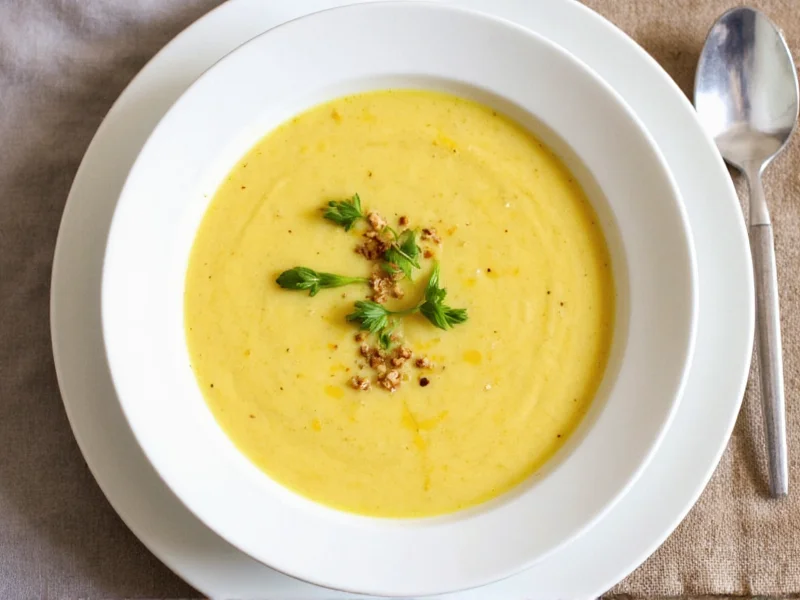The Art of Perfect Egg Flower Soup: Beyond Basic Recipes
Egg flower soup (蛋花汤, dàn huā tāng) has been warming Chinese households for centuries, evolving from imperial kitchen delicacy to everyday comfort food. While many Westernized versions oversimplify this dish, authentic preparation balances texture, temperature control, and subtle seasoning to create that signature silky broth with elegant egg ribbons.
Why This Recipe Works: Culinary Science Behind the Soup
The magic happens through protein denaturation—when hot broth (180-190°F) hits the egg proteins, they coagulate into delicate strands rather than scrambling. Temperature control is critical: too hot and eggs scramble, too cool and they won't form proper ribbons. The cornstarch slurry (1:1 ratio with cold water) creates just enough viscosity to support the egg ribbons without making the soup gloopy—a common mistake in restaurant-style egg drop soup recipes.
Essential Ingredients Breakdown
Quality ingredients make the difference between mediocre and exceptional egg flower soup. Here's what you need:
| Ingredient | Why It Matters | Pro Tip |
|---|---|---|
| Homemade broth | Provides deep umami base | Use chicken bones simmered 4+ hours or mushroom dashi for vegetarian version |
| Fresh eggs | Creates tender, flavorful ribbons | Room temperature eggs incorporate better into hot broth |
| Cornstarch | Controls broth viscosity | Mix with COLD water first to prevent lumps |
| Sesame oil | Adds aromatic finish | Always add AFTER removing from heat to preserve flavor |
Step-by-Step Technique Guide
Follow these precise steps for restaurant-quality results at home:
- Prepare broth: Heat 4 cups homemade broth to 180-190°F (simmering but not boiling)
- Make slurry: Whisk 1 tbsp cornstarch with 2 tbsp cold water until smooth
- Thicken broth: Slowly pour slurry into broth while stirring constantly; cook 1 minute until slightly translucent
- Prepare eggs: Beat 2 large eggs with 1 tbsp water until uniform but not frothy
- Create egg ribbons: Reduce heat to low, pour beaten eggs in thin, steady stream while stirring broth in ONE direction
- Finish: Remove from heat immediately when eggs form ribbons (5-10 seconds), add green onions and sesame oil
Common Mistakes & How to Avoid Them
Even experienced cooks struggle with these egg flower soup pitfalls:
- Scrambled eggs instead of ribbons: Broth too hot (above 200°F) or pouring eggs too quickly. Solution: Use thermometer and pour eggs in thin, steady stream
- Watery texture: Insufficient thickening. Solution: Use proper cornstarch ratio (1 tbsp per 4 cups broth)
- Bland flavor: Weak broth base. Solution: Simmer bones or mushrooms at least 2 hours for depth
- Muddy egg color: Over-stirring after adding eggs. Solution: Stir broth in one direction only while adding eggs, then stop immediately
Creative Variations for Every Kitchen
Once you've mastered the traditional egg flower soup recipe, try these authentic adaptations:
- Vegetarian version: Substitute mushroom dashi for chicken broth, add wood ear mushrooms for texture
- Protein boost: Add shredded cooked chicken or tofu cubes before pouring eggs
- Spicy Sichuan style: Finish with 1/2 tsp chili oil and white pepper
- Gluten-free option: Ensure broth is GF-certified; replace soy sauce with tamari if seasoning
- Low-sodium version: Use unsalted broth and enhance flavor with extra green onions and ginger
Serving & Storage Tips
Egg flower soup is best enjoyed immediately, but these tips help maintain quality:
- Serve in pre-warmed bowls to maintain temperature
- Pair with steamed rice and stir-fried vegetables for complete meal
- Refrigerate leftovers up to 2 days (egg texture deteriorates after day 1)
- Reheat gently on stove—never microwave—as high heat destroys delicate egg ribbons
- For meal prep: Store broth and egg mixture separately, combining only when serving
Frequently Asked Questions
Can I make egg flower soup without cornstarch?
Yes, though the texture will differ. Traditional Cantonese versions often skip thickening agents. For best results without cornstarch, use a richer broth (simmer bones 6+ hours) and reduce broth by 25% before adding eggs. The soup will be more delicate and brothy rather than the thicker restaurant-style version.
Why does my egg drop soup turn into scrambled eggs?
This happens when broth temperature exceeds 200°F or when eggs are poured too quickly. Maintain broth at 180-190°F (just below simmering) and pour beaten eggs in a very thin, steady stream while stirring broth in one direction. Remove from heat immediately after adding eggs—the residual heat completes the cooking.
How can I make egg flower soup thicker like restaurant versions?
Restaurants often use slightly more cornstarch (1.5 tbsp per 4 cups broth) and sometimes add a pinch of baking soda to the egg mixture, which creates fluffier ribbons. For authentic thickening, ensure your cornstarch slurry is properly mixed with cold water first, then simmer broth 2 minutes after adding slurry before incorporating eggs.
What's the difference between egg drop soup and egg flower soup?
They're the same dish—"egg flower soup" is the more accurate translation of 蛋花汤 (dàn huā tāng). Western restaurants often call it "egg drop soup," but the technique creating the "flower" pattern of egg ribbons is what defines authentic preparation. The name refers to the blossom-like appearance of properly formed egg strands.
Can I use egg whites only for a lighter version?
Yes, though traditional recipes use whole eggs. For egg white soup, beat 3 egg whites with 1 tbsp water. The ribbons will be more delicate and the soup lighter in both color and texture. This works well for low-cholesterol diets while maintaining the signature egg swirl technique that defines authentic egg flower soup recipes.











 浙公网安备
33010002000092号
浙公网安备
33010002000092号 浙B2-20120091-4
浙B2-20120091-4